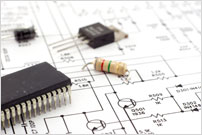November 2009 Issue
A summary of this month's contents.
Teach-In 2010: Ladder Logic programming for the PICMicro.
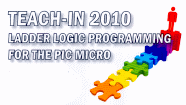 Our universally applauded Teach-In series launches in this issue with Teach-In 2010: Ladder Logic programming for the PICMicro. In the first of six articles, we describe programming a PIC micro using an approach called ‘ladder logic’. This PLC-style (Programmable Logic Controller) technique is very easy to configure and is very popular with engineers. Teach-In 2010 will also demonstrate simple combinational logic, timers, shift registers, counters and more.
Our universally applauded Teach-In series launches in this issue with Teach-In 2010: Ladder Logic programming for the PICMicro. In the first of six articles, we describe programming a PIC micro using an approach called ‘ladder logic’. This PLC-style (Programmable Logic Controller) technique is very easy to configure and is very popular with engineers. Teach-In 2010 will also demonstrate simple combinational logic, timers, shift registers, counters and more.
Our contributor Walter Ditch has released the corresponding software free of charge and it can be downloaded from the EPE Library. It is intended to work with Microchip’s MPLAB IDE and currently works with five different PICmicros alongside several commercial hardware/ software platforms (e.g. Velleman K8048), PICkit2 by Microchip Express, Matrix Multimedia V3 PICmicro MCU board or Labcenter Electronics’ Proteus VSM simulation software.
Teach-In 2010 promises a different approach to learning the language of PICmicro programming, so if you have been deterred by the complexities of programming then Teach-In 2010: Ladder Logic programming for the PICMicro might be a refreshing the way of opening the world of microcontrollers to you.
Class-A Headphone Amplifier
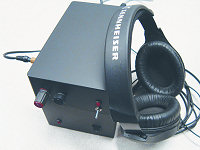 A superb project for the audio fan, this Class-A based amplifier can be connected into an existing amplifier to drive headphones with a good solid audio signal. Ideal for systems that lack any headphone provision, it will drive a variety of headphones and impedances from 30R to 250R.
A superb project for the audio fan, this Class-A based amplifier can be connected into an existing amplifier to drive headphones with a good solid audio signal. Ideal for systems that lack any headphone provision, it will drive a variety of headphones and impedances from 30R to 250R. 
High quality stereo design with separate mains power supply. Full constructional details included in full colour.
Programmable Ignition System for Cars (Part 3)
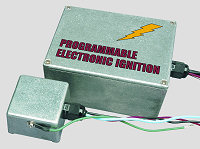 This professional system is suitable for use by experienced and advanced constructors and can be utilised as a complete engine ignition system or as an interceptor. This immensely useful PICmicro-controlled module allows auto tuning experts to precisely adjust the characteristics of a vehicle’s ignition system. It is a completely stand-alone system for most 2 stroke and 4 stroke engines that is triggered by an engine position sensor and then drives the ignition coil. It can be triggered from a variety of distributor sensors including contact breaker points, reluctor, Hall effect, opto or the 5V signal from an engine’s ECU. A plug-in LCD hand controller shows values and settings on a digital display, allowing the timing to be advanced or retarded from the remote controller.
This professional system is suitable for use by experienced and advanced constructors and can be utilised as a complete engine ignition system or as an interceptor. This immensely useful PICmicro-controlled module allows auto tuning experts to precisely adjust the characteristics of a vehicle’s ignition system. It is a completely stand-alone system for most 2 stroke and 4 stroke engines that is triggered by an engine position sensor and then drives the ignition coil. It can be triggered from a variety of distributor sensors including contact breaker points, reluctor, Hall effect, opto or the 5V signal from an engine’s ECU. A plug-in LCD hand controller shows values and settings on a digital display, allowing the timing to be advanced or retarded from the remote controller.
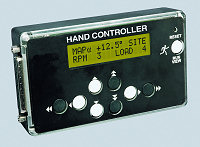 Options include built-in or off-board pressure sensing to measure engine load and an optional knock-sensor helps overcome pinking. For experts, the system can replace existing ignition timing using the vehicle’s advance/ retard curves, or it can be used as a timing interceptor. The design may also be fitted to older engines. Suits 1-12 cylinders 4 stroke and 1-6 cylinders 2-stroke. In Part 3 we describe installation, setting up and plotting an engine’s vehicle timing characteristics.
Options include built-in or off-board pressure sensing to measure engine load and an optional knock-sensor helps overcome pinking. For experts, the system can replace existing ignition timing using the vehicle’s advance/ retard curves, or it can be used as a timing interceptor. The design may also be fitted to older engines. Suits 1-12 cylinders 4 stroke and 1-6 cylinders 2-stroke. In Part 3 we describe installation, setting up and plotting an engine’s vehicle timing characteristics.
![]() WARNING Programming an incorrect timing map into the Ignition Timing Module could cause serious engine damage. Do NOT modify your car by fitting this device unless you know what you are doing.
WARNING Programming an incorrect timing map into the Ignition Timing Module could cause serious engine damage. Do NOT modify your car by fitting this device unless you know what you are doing.
DDS DFO with mobile phone Graphics LCD
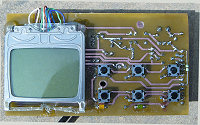
A direct digital synthesis (DDS) variable frequency oscillator that uses a widely available recycled Nokia mobile phone LCD to display analogue and digital frequency readouts, text and VFO status. Atmel AT89C4051-based, free source code available from the EPEmag Library.
Emergency 12V Lighting Controller
 This easily-built project automatically powers up 12V emergency lighting within a second or two of mains failure. It uses a common 12V sealed lead acid (SLA) mains adapter/ charger and the charging voltage is monitored to determine when there has been a mains failure. Built-in 12V 7.2Ah SLA with MOSFET output can power e.g. several 12V fluorescent tubes for several hours.
This easily-built project automatically powers up 12V emergency lighting within a second or two of mains failure. It uses a common 12V sealed lead acid (SLA) mains adapter/ charger and the charging voltage is monitored to determine when there has been a mains failure. Built-in 12V 7.2Ah SLA with MOSFET output can power e.g. several 12V fluorescent tubes for several hours.
Also in this issue:
- Recycle It! Delves into the inner workings of old photocopiers, in search of juicy spares that can be given a second life.
- Circuit Surgery discusses the meaning of Time Domain Response in the context of filter design.
- PIC n MIX brings you Part 2 of its discussion on Real Time Operating Systems.
- Practically Speaking, our feature for workshop techniques, gives the low-down on labelling techniques for your projects.
- Techno Talk brings you up to date with WEEE and lifts the lid on some illegal practises and after-effects related to recycling of old equipment.
- Net Work looks at the next crop of anti virus products.
There’s advertisements and more features in Everyday Practical Electronics every month. EPE is available both as a printed magazine or digital download – subscribe now!
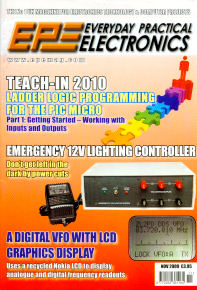
Source code 1109.zip inc. Teach-In 2010 files
PCB files pcb1109.zip
![]() Source codes for Teach-In 2010: Ladder Logic programming for the PICMicro are also available for free download in the Teach-In section of our Library.
Source codes for Teach-In 2010: Ladder Logic programming for the PICMicro are also available for free download in the Teach-In section of our Library.

